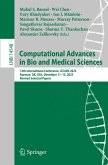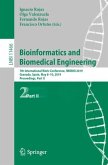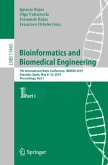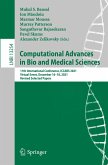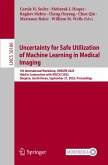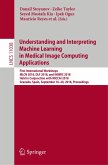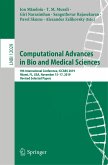Computational Advances in Bio and Medical Sciences
13th International Conference, ICCABS 2025, Atlanta, GA, USA, January 12-14, 2025, Revised Selected Papers
Herausgegeben:Alser, Mohammed; Bansal, Mukul S.; Khudyakov, Yury; Mangul, Serghei; Mandoiu, Ion I.; Moussa, Marmar R.; Patterson, Murray; Rajasekaran, Sanguthevar; Skums, Pavel; Yooseph, Shibu; Zelikovsk
Computational Advances in Bio and Medical Sciences
13th International Conference, ICCABS 2025, Atlanta, GA, USA, January 12-14, 2025, Revised Selected Papers
Herausgegeben:Alser, Mohammed; Bansal, Mukul S.; Khudyakov, Yury; Mangul, Serghei; Mandoiu, Ion I.; Moussa, Marmar R.; Patterson, Murray; Rajasekaran, Sanguthevar; Skums, Pavel; Yooseph, Shibu; Zelikovsk
- Broschiertes Buch
- Merkliste
- Auf die Merkliste
- Bewerten Bewerten
- Teilen
- Produkt teilen
- Produkterinnerung
- Produkterinnerung
This book constitutes the refereed proceedings of the 13th International Conference on Computational Advances in Bio and Medical Sciences, ICCABS 2025, held in Atlanta, GA, USA, during January 12 14, 2025.
The 26 full papers presented in these proceedings were carefully reviewed and selected from 75 submissions. ICCABS has the goal of bringing together researchers, scientists, and students from academia, laboratories, and industry to discuss recent advances on computational techniques and applications in the areas of biology, medicine, and drug discovery.
Andere Kunden interessierten sich auch für
![Computational Advances in Bio and Medical Sciences Computational Advances in Bio and Medical Sciences]() Computational Advances in Bio and Medical Sciences42,99 €
Computational Advances in Bio and Medical Sciences42,99 €![Bioinformatics and Biomedical Engineering Bioinformatics and Biomedical Engineering]() Bioinformatics and Biomedical Engineering62,99 €
Bioinformatics and Biomedical Engineering62,99 €![Bioinformatics and Biomedical Engineering Bioinformatics and Biomedical Engineering]() Bioinformatics and Biomedical Engineering62,99 €
Bioinformatics and Biomedical Engineering62,99 €![Computational Advances in Bio and Medical Sciences Computational Advances in Bio and Medical Sciences]() Computational Advances in Bio and Medical Sciences42,99 €
Computational Advances in Bio and Medical Sciences42,99 €![Uncertainty for Safe Utilization of Machine Learning in Medical Imaging Uncertainty for Safe Utilization of Machine Learning in Medical Imaging]() Uncertainty for Safe Utilization of Machine Learning in Medical Imaging44,99 €
Uncertainty for Safe Utilization of Machine Learning in Medical Imaging44,99 €![Understanding and Interpreting Machine Learning in Medical Image Computing Applications Understanding and Interpreting Machine Learning in Medical Image Computing Applications]() Understanding and Interpreting Machine Learning in Medical Image Computing Applications38,99 €
Understanding and Interpreting Machine Learning in Medical Image Computing Applications38,99 €![Computational Advances in Bio and Medical Sciences Computational Advances in Bio and Medical Sciences]() Computational Advances in Bio and Medical Sciences38,99 €
Computational Advances in Bio and Medical Sciences38,99 €-
-
-
This book constitutes the refereed proceedings of the 13th International Conference on Computational Advances in Bio and Medical Sciences, ICCABS 2025, held in Atlanta, GA, USA, during January 12 14, 2025.
The 26 full papers presented in these proceedings were carefully reviewed and selected from 75 submissions. ICCABS has the goal of bringing together researchers, scientists, and students from academia, laboratories, and industry to discuss recent advances on computational techniques and applications in the areas of biology, medicine, and drug discovery.
The 26 full papers presented in these proceedings were carefully reviewed and selected from 75 submissions. ICCABS has the goal of bringing together researchers, scientists, and students from academia, laboratories, and industry to discuss recent advances on computational techniques and applications in the areas of biology, medicine, and drug discovery.
Produktdetails
- Produktdetails
- Lecture Notes in Computer Science 15599
- Verlag: Springer / Springer Nature Switzerland / Springer, Berlin
- Artikelnr. des Verlages: 89549455, 978-3-032-02488-6
- Seitenzahl: 372
- Erscheinungstermin: 1. November 2025
- Englisch
- Abmessung: 235mm x 155mm x 21mm
- Gewicht: 564g
- ISBN-13: 9783032024886
- ISBN-10: 3032024889
- Artikelnr.: 74898975
- Herstellerkennzeichnung
- Springer-Verlag GmbH
- Tiergartenstr. 17
- 69121 Heidelberg
- ProductSafety@springernature.com
- Lecture Notes in Computer Science 15599
- Verlag: Springer / Springer Nature Switzerland / Springer, Berlin
- Artikelnr. des Verlages: 89549455, 978-3-032-02488-6
- Seitenzahl: 372
- Erscheinungstermin: 1. November 2025
- Englisch
- Abmessung: 235mm x 155mm x 21mm
- Gewicht: 564g
- ISBN-13: 9783032024886
- ISBN-10: 3032024889
- Artikelnr.: 74898975
- Herstellerkennzeichnung
- Springer-Verlag GmbH
- Tiergartenstr. 17
- 69121 Heidelberg
- ProductSafety@springernature.com
.- A Benchmarking Study of Random Projections and Principal Components for Dimensionality Reduction Strategies in Single Cell Analysis.
.- Resistance genes are distinct in protein-protein interaction networks according to drug class and gene mobility.
.- DuoHash: fast hashing of spaced seeds with application to spaced k-mers counting.
.- Unsupervised Learning for Tertiary Structure Prediction of Protein Molecules: Systematic Review.
.- Fast and Succinct Compression of k-mer Sets with Plain Text Representation of Colored de Bruijn Graphs.
.- Enhancing Protein Side Chain Packing Using Rotamer Clustering and Machine Learning.
.- Can Language Models Reason about ICD Codes to Guide the Generation of Clinical Notes?.
.- Link Prediction in Disease-Disease Interactions Network Using a Hybrid Deep Learning Model.
.- Model Selection for Sparse Microbial Network Inference using Variational Approximation.
.- Haplotype-based Parallel PBWT for Biobank Scale Data.
.- Mammo-Bench: A Large-scale Benchmark Dataset of Mammography Images.
.- MetaEdit: Computational Identification of RNA editing in Microbiomes.
.- Drug-centric prior improves drug response modeling in partially overlapping pharmacogenomic screens.
.- Improving inter-helical residue contact prediction in -helical Transmembrane proteins using structural neighborhood crowdedness information.
.- Explaining Protein Folding Networks Using Integrated Gradients and Attention Mechanisms.
.- The evolution of cancer progression risk: a phylogenetic and machine learning analysis.
.- Cancer Diseases Classification with Sparse Neural Networks: An Information-Theoretic Approach.
.- Epistatic Density of Viral Variants in Acute and Chronic HCV patients.
.- Applying Genetic Algorithm with Saltations to MAX-3SAT.
.- Computing Gram Matrix for SMILES Strings using RDKFingerprint and Sinkhorn-Knopp Algorithm.
.- Enhancing Privacy Preservation and Reducing Analysis Time with Federated Transfer Learning in Digital Twins-based CT Scan Analysis.
.- Improved Graph-Based Antibody-Aware Epitope Prediction with Protein Language Model-Based Embeddings.
.- Leveraging RNA LLMs for 3D Structure Prediction via Novel Data Augmentation.
.- EfficientNet in Digital Twin-based Cardiac Arrest Prediction and Analysis.
.- AmpliconHunter: A Scalable Tool for Accurate Amplicon Prediction from Microbiome Samples using Degenerate Primers.
.- Neuromorphic Spiking Neural Network Based Classification of COVID-19 Spike Sequences.
.- Resistance genes are distinct in protein-protein interaction networks according to drug class and gene mobility.
.- DuoHash: fast hashing of spaced seeds with application to spaced k-mers counting.
.- Unsupervised Learning for Tertiary Structure Prediction of Protein Molecules: Systematic Review.
.- Fast and Succinct Compression of k-mer Sets with Plain Text Representation of Colored de Bruijn Graphs.
.- Enhancing Protein Side Chain Packing Using Rotamer Clustering and Machine Learning.
.- Can Language Models Reason about ICD Codes to Guide the Generation of Clinical Notes?.
.- Link Prediction in Disease-Disease Interactions Network Using a Hybrid Deep Learning Model.
.- Model Selection for Sparse Microbial Network Inference using Variational Approximation.
.- Haplotype-based Parallel PBWT for Biobank Scale Data.
.- Mammo-Bench: A Large-scale Benchmark Dataset of Mammography Images.
.- MetaEdit: Computational Identification of RNA editing in Microbiomes.
.- Drug-centric prior improves drug response modeling in partially overlapping pharmacogenomic screens.
.- Improving inter-helical residue contact prediction in -helical Transmembrane proteins using structural neighborhood crowdedness information.
.- Explaining Protein Folding Networks Using Integrated Gradients and Attention Mechanisms.
.- The evolution of cancer progression risk: a phylogenetic and machine learning analysis.
.- Cancer Diseases Classification with Sparse Neural Networks: An Information-Theoretic Approach.
.- Epistatic Density of Viral Variants in Acute and Chronic HCV patients.
.- Applying Genetic Algorithm with Saltations to MAX-3SAT.
.- Computing Gram Matrix for SMILES Strings using RDKFingerprint and Sinkhorn-Knopp Algorithm.
.- Enhancing Privacy Preservation and Reducing Analysis Time with Federated Transfer Learning in Digital Twins-based CT Scan Analysis.
.- Improved Graph-Based Antibody-Aware Epitope Prediction with Protein Language Model-Based Embeddings.
.- Leveraging RNA LLMs for 3D Structure Prediction via Novel Data Augmentation.
.- EfficientNet in Digital Twin-based Cardiac Arrest Prediction and Analysis.
.- AmpliconHunter: A Scalable Tool for Accurate Amplicon Prediction from Microbiome Samples using Degenerate Primers.
.- Neuromorphic Spiking Neural Network Based Classification of COVID-19 Spike Sequences.
.- A Benchmarking Study of Random Projections and Principal Components for Dimensionality Reduction Strategies in Single Cell Analysis.
.- Resistance genes are distinct in protein-protein interaction networks according to drug class and gene mobility.
.- DuoHash: fast hashing of spaced seeds with application to spaced k-mers counting.
.- Unsupervised Learning for Tertiary Structure Prediction of Protein Molecules: Systematic Review.
.- Fast and Succinct Compression of k-mer Sets with Plain Text Representation of Colored de Bruijn Graphs.
.- Enhancing Protein Side Chain Packing Using Rotamer Clustering and Machine Learning.
.- Can Language Models Reason about ICD Codes to Guide the Generation of Clinical Notes?.
.- Link Prediction in Disease-Disease Interactions Network Using a Hybrid Deep Learning Model.
.- Model Selection for Sparse Microbial Network Inference using Variational Approximation.
.- Haplotype-based Parallel PBWT for Biobank Scale Data.
.- Mammo-Bench: A Large-scale Benchmark Dataset of Mammography Images.
.- MetaEdit: Computational Identification of RNA editing in Microbiomes.
.- Drug-centric prior improves drug response modeling in partially overlapping pharmacogenomic screens.
.- Improving inter-helical residue contact prediction in -helical Transmembrane proteins using structural neighborhood crowdedness information.
.- Explaining Protein Folding Networks Using Integrated Gradients and Attention Mechanisms.
.- The evolution of cancer progression risk: a phylogenetic and machine learning analysis.
.- Cancer Diseases Classification with Sparse Neural Networks: An Information-Theoretic Approach.
.- Epistatic Density of Viral Variants in Acute and Chronic HCV patients.
.- Applying Genetic Algorithm with Saltations to MAX-3SAT.
.- Computing Gram Matrix for SMILES Strings using RDKFingerprint and Sinkhorn-Knopp Algorithm.
.- Enhancing Privacy Preservation and Reducing Analysis Time with Federated Transfer Learning in Digital Twins-based CT Scan Analysis.
.- Improved Graph-Based Antibody-Aware Epitope Prediction with Protein Language Model-Based Embeddings.
.- Leveraging RNA LLMs for 3D Structure Prediction via Novel Data Augmentation.
.- EfficientNet in Digital Twin-based Cardiac Arrest Prediction and Analysis.
.- AmpliconHunter: A Scalable Tool for Accurate Amplicon Prediction from Microbiome Samples using Degenerate Primers.
.- Neuromorphic Spiking Neural Network Based Classification of COVID-19 Spike Sequences.
.- Resistance genes are distinct in protein-protein interaction networks according to drug class and gene mobility.
.- DuoHash: fast hashing of spaced seeds with application to spaced k-mers counting.
.- Unsupervised Learning for Tertiary Structure Prediction of Protein Molecules: Systematic Review.
.- Fast and Succinct Compression of k-mer Sets with Plain Text Representation of Colored de Bruijn Graphs.
.- Enhancing Protein Side Chain Packing Using Rotamer Clustering and Machine Learning.
.- Can Language Models Reason about ICD Codes to Guide the Generation of Clinical Notes?.
.- Link Prediction in Disease-Disease Interactions Network Using a Hybrid Deep Learning Model.
.- Model Selection for Sparse Microbial Network Inference using Variational Approximation.
.- Haplotype-based Parallel PBWT for Biobank Scale Data.
.- Mammo-Bench: A Large-scale Benchmark Dataset of Mammography Images.
.- MetaEdit: Computational Identification of RNA editing in Microbiomes.
.- Drug-centric prior improves drug response modeling in partially overlapping pharmacogenomic screens.
.- Improving inter-helical residue contact prediction in -helical Transmembrane proteins using structural neighborhood crowdedness information.
.- Explaining Protein Folding Networks Using Integrated Gradients and Attention Mechanisms.
.- The evolution of cancer progression risk: a phylogenetic and machine learning analysis.
.- Cancer Diseases Classification with Sparse Neural Networks: An Information-Theoretic Approach.
.- Epistatic Density of Viral Variants in Acute and Chronic HCV patients.
.- Applying Genetic Algorithm with Saltations to MAX-3SAT.
.- Computing Gram Matrix for SMILES Strings using RDKFingerprint and Sinkhorn-Knopp Algorithm.
.- Enhancing Privacy Preservation and Reducing Analysis Time with Federated Transfer Learning in Digital Twins-based CT Scan Analysis.
.- Improved Graph-Based Antibody-Aware Epitope Prediction with Protein Language Model-Based Embeddings.
.- Leveraging RNA LLMs for 3D Structure Prediction via Novel Data Augmentation.
.- EfficientNet in Digital Twin-based Cardiac Arrest Prediction and Analysis.
.- AmpliconHunter: A Scalable Tool for Accurate Amplicon Prediction from Microbiome Samples using Degenerate Primers.
.- Neuromorphic Spiking Neural Network Based Classification of COVID-19 Spike Sequences.


